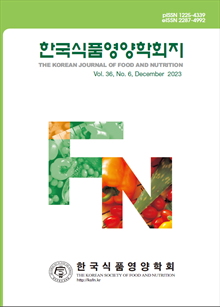간행물
한국식품영양학회지 KCI 등재 The Korean Journal of Food And Nutrition

- 발행기관 한국식품영양학회
- 자료유형 학술지
- 간기 격월간
- ISSN 1225-4339 (Print)2287-4992 (Online)
- 수록기간 1988 ~ 2024
- 주제분류 자연과학 > 생활과학 자연과학 분류의 다른 간행물
- 십진분류KDC 594DDC 641
권호리스트/논문검색
Vol. 27 No. 4 (2014년 8월) 24건
21.
2014.08
구독 인증기관 무료, 개인회원 유료
This study was conducted as a comparative analysis, using the SPSS 17.0 program for a survey conducted from March to July 2013, on the level of perception and preference factors of Koreans and Americans residing in Virginia, USA(89 male and female adults of 20 years of age or above). For the information on the degree of obesity, a survey was used and the subjects provided with their heights and weights. The researcher used this data to calculated their BMI and distinguished the degrees of obesity. For the BMI, the obesity diagnosis of Korean Society for the Study of Obesity was used for Koreans, and the WHO's obesity diagnosis on adults were employed for Americans. First, regarding the Korean participants, the level of obesity appeared in the order of normal (79.6%), overweight (14.3%), and underweight (6.1%). Also, the level of perceptions of their health conditions appeared in the order of average (51.7%) and good (34.7%). No one perceived their health to be in poor condition. Meanwhile, for the American participants, the order was as follows: overweight at about 45%, normal weight at about 35%, obesity at about 12.5%, and underweight at about 7.5%. In terms of the level of perception of health during ordinary times, about 55% of the American participants answered that they are in good health. Therefore, the Americans were found to perceive their health to be in relatively better condition than the Koreans residing in the USA. Also, concerning the level of interest in health while eating food at ordinary times, the American participants were discovered to be more interested (about 62.5%) than the Korean participants. The research on their preference for salty taste was conducted as a survey, and the subjects were asked to choose an item according to their subjective feeling. Regarding the preference for salty taste, both Koreans and Americans residing in the USA responded as moderate. However, a higher proportion of Americans than Koreans responded to favor salty taste. Concerning the reason for their preference for salty taste, Koreans responded with various reasons whereas Americans mostly responded that it is because they eat salty food frequently. For any changes in dietary behavior related to eating salty food, both Korean and American respondents thought that the amount of their daily intake of salt is appropriate and that they consider taste as most important in selecting a snack. Based on the above data, the results of this research indicate a need for actual improvement in the diet with regard to salty food along with diverse policies for promoting life with a low salt diet in future.
4,000원
22.
2014.08
구독 인증기관 무료, 개인회원 유료
본 연구에서는 nicotine 분해에 효과에 대하여 해양식물 유래의 후코이단을 이용하여 시험관에서 직접 혼합법 및 세포주 시험에서 nicotine의 cotinine으로의 전환능을 측정하였다. 직접 혼합법 시험결과, 후코이단 1 μg/mL에서 시간이 경과함에 따라서 nicotine의 cotinine으로의 전환 정도가 대조군 대비 증가하여 시험 종료 시점에서 15배의 증가율을 나타내었다. 세포주을 이용한 nicotine의 분해능 시험 결과, 시험 종료 시점에서 대조군 대비 6배의 cotinine 증가율을 나타내었다. 양성 대조군으로 사용한 녹차 추출물 대비 nicotine 분해능은 우수한 것으로 평가되었다. 그러나 후코이단의 항산화능은 녹차 추출물과 대비하여 낮았으며, 항산화 주요 기능을 갖는 폴리페놀 및 플라보노이드 성분 역시 낮았다. 본 시험 결과가 나타내는 바는 후코이단의 nicotine의 cotinine으로의 전환능에 대한 입증을 하였으며 이는 금연 보조 역할을 할 수 있는 기능성 소재로 사료된다.
4,000원
23.
2014.08
구독 인증기관 무료, 개인회원 유료
Korean foods have the strengths to addresssome of the health problems of modern man. To assess the properties of Korean noodles, daily value %, DVS, DDS and energy density were compared between many kinds of noodles from around the world. Using a variety of reference materials, a nutritional database of noodles was built for this study. For carbohydrate, lipid, vitamin A, vitamin K, vitamin C, niacin, zinc, and copper, the daily values % of western noodles were significantly higher. Also, the serving size of Korean noodles was significantly small. Comparing the average energy density of the noodles, they showed 1.87±0.93 kcal/g (Korean noodles), 2.42±1.08 kcal/g (western noodles) and 1.84±0.84 kcal/g (other noodles). The dietary fiber, polyphenols, and flavonoids content of the noodles showed no significant difference. Neither DVS nor DDS showed a statistically significant difference. In the Korean noodles, the GMDFV pattern showed a diverse choice of food groups. Korean noodles show a lower energy density, and the small serving size to have favorable for the prevention of obesity. Thus, Korean noodles are an excellent choice in terms of diversity and energy density.
4,000원
24.
2014.08
구독 인증기관 무료, 개인회원 유료
This study was done in order to investigate the changes in quality of Cheonggukjang for soybean cultivars during fermentation. Cheonggukjang of 14 cultivars that were inoculated with Bacillus subtilis 15893 was produced, and, then, it was measured for hardness, proximate composition, amino nitrogen, enzyme activity, and total aerobic bacteria counts. In a raw bean, the highest hardness value was 16,975 g from Sunyu. In a steaming bean, Jangwon had the highest hardness value and the lowest aerobic bacteria counts of forty-eight hours fermented Cheonggukjang. Saedanbaek, whose protein contents was highest in raw bean, was also highest in Cheonggukjang. The amino nitrogen content of twenty-four hours fermented Cheonggukjang was highest in Saeol and Sunyu while forty-eight hours fermented Cheonggukjang was highest in Singi, Daol, and Milyang 231. In the protease activity, Saedanbaek had the highest and total aerobic bacteria count that were either increased or held as time went on ; twenty-four hours fermented Cheonggukjang was highest in Milyang 231 and Keunol while forty-eight hours fermented Cheonggukjang was highest in Chunsang.
4,000원
1
2

